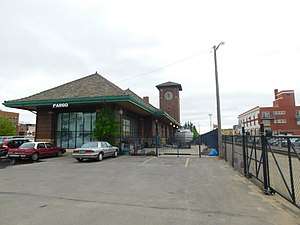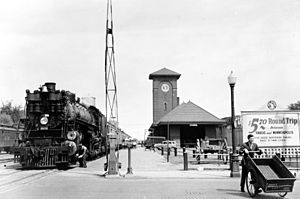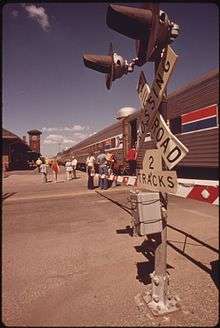Fargo station
Fargo is a train station in Fargo, North Dakota, United States. It is served by Amtrak's Empire Builder. It is the only railway station in use in the Fargo-Moorhead area and is the third-busiest in North Dakota. The platform, tracks, and station are currently all owned by BNSF Railway. The station is currently located in the former BNSF freight house. The former main station building is now home to Great Northern Bicycle Co.
Fargo, ND | ||||||||||||||||||||||||||||||||||||
|---|---|---|---|---|---|---|---|---|---|---|---|---|---|---|---|---|---|---|---|---|---|---|---|---|---|---|---|---|---|---|---|---|---|---|---|---|
 Fargo station in May 2017. The former Great Northern depot is on the left while the closed-off platform is on the right. | ||||||||||||||||||||||||||||||||||||
| Location | 420 4th Street North Fargo, ND 58102, U.S. | |||||||||||||||||||||||||||||||||||
| Owned by | BNSF Railway | |||||||||||||||||||||||||||||||||||
| Line(s) | BNSF Railway KO Subdivision | |||||||||||||||||||||||||||||||||||
| Platforms | 1 side platform | |||||||||||||||||||||||||||||||||||
| Tracks | 1 | |||||||||||||||||||||||||||||||||||
| Construction | ||||||||||||||||||||||||||||||||||||
| Parking | Yes; free | |||||||||||||||||||||||||||||||||||
| Disabled access | Yes | |||||||||||||||||||||||||||||||||||
| Other information | ||||||||||||||||||||||||||||||||||||
| Station code | FAR | |||||||||||||||||||||||||||||||||||
| History | ||||||||||||||||||||||||||||||||||||
| Opened | 1906 | |||||||||||||||||||||||||||||||||||
| Rebuilt | 1995 | |||||||||||||||||||||||||||||||||||
| Traffic | ||||||||||||||||||||||||||||||||||||
| Passengers (2016) | 21,586[1] | |||||||||||||||||||||||||||||||||||
| Services | ||||||||||||||||||||||||||||||||||||
| ||||||||||||||||||||||||||||||||||||
| ||||||||||||||||||||||||||||||||||||
Great Northern Depot | ||||||||||||||||||||||||||||||||||||
  | ||||||||||||||||||||||||||||||||||||
| Coordinates | 46°52′52″N 96°47′10″W | |||||||||||||||||||||||||||||||||||
| Built | 1906 | |||||||||||||||||||||||||||||||||||
| Architect | Samuel L. Bartlett | |||||||||||||||||||||||||||||||||||
| Architectural style | Romanesque Revival | |||||||||||||||||||||||||||||||||||
| Part of | Downtown Fargo District (ID83004064) | |||||||||||||||||||||||||||||||||||
| Added to NRHP | October 13, 1983.[2] | |||||||||||||||||||||||||||||||||||
History

Fargo station was originally built by the Great Northern Railway in 1906. It was designed by Samuel L. Bartlett in a Romanesque Revival style. He also designed other stations for the Great Northern, including stations in Minot and Rugby, North Dakota.[2] The Great Northern also built a nearby freight warehouse in Fargo, listed on the National Register of Historic Places.[3]
At the time of the station's construction, Fargo was served by both the Great Northern Railway and the Northern Pacific.[4] The station was served by Great Northern trains, while Northern Pacific operated its own station along Fargo's Main Avenue.
In 1970, the two railway companies merged to form the Burlington Northern. Freight trains used the Northern Pacific tracks, while passenger trains used the Great Northern tracks. All passenger service in Fargo began using the Great Northern depot. From 1971, passenger service was operated by Amtrak.[5]

Amtrak currently uses the former BNSF freight house as the station building, as the main building became unused in 1986. The former main station building is now used for retail. Various businesses have operated in the building, since 1995.[5]
Fargo station is listed as a contributing property on National Register of Historic Places Downtown Fargo District as the Great Northern Depot.[2]
Operation
Fargo station is served by Amtrak's Empire Builder service. Westbound trains are headed for Spokane, Washington (splitting to serve Seattle, Washington and Portland, Oregon) while eastbound trains are headed for Chicago. There are several intermittent stops between. About one-eighth of Empire Builder passengers board or alight at this station.
The station previously served the North Coast Hiawatha until that was consolidated into the Empire Builder in 1979.
The Minnesota Department of Transportation has proposed regional rail services to connect Fargo-Moorhead with the Twin Cities in Minnesota. The route is listed as a Phase 1 project for Minnesota's regional rail projects, to be completed by 2030. Due to existing infrastructure, Fargo Amtrak station would be used.[6]
Ridership
While the largest city in North Dakota, Fargo has only the third-most rail passenger traffic in the state, behind Minot and Williston. This is chiefly because Amtrak's daily Empire Builder, which makes stops in six other North Dakota cities, stops in Fargo during the middle of night—between 2 am and 4 am—on both its eastbound and westbound journeys. In Amtrak's 2010 fiscal year, an average of about 60 passengers boarded or detrained at the station each day[7]
References
- "Amtrak Fact Sheet, FY2016, State of North Dakota" (PDF). Amtrak. November 2016. Retrieved March 11, 2017.
- Roberts, Norene A. (December 4, 1982). "Downtown Fargo District". Minneapolis: National Park Service. p. 22. Retrieved April 28, 2020.
- Roberts, Norene (March 4, 1989). "Great Northern Freight Warehouse". Minneapolis: National Park Service. Retrieved April 28, 2020.
- "Multiple Property Documentation Form: Railroads in North Dakota, 1872-1956" (PDF). National Register of Historic Places. United States Department of the Interior. Retrieved November 4, 2012.
- "Fargo, N.D.: Great Northern Railway Depot". History Exhibition. Institute for Regional Studies, North Dakota State University. Archived from the original on December 12, 2012. Retrieved November 7, 2012.
- "Minnesota Comprehensive Statewide Freight and Passenger Rail Plan" (PDF). Minnesota Department of Transportation. Retrieved November 4, 2012.
- "Amtrak Fact Sheet, FY2010, State of North Dakota" (PDF). Amtrak. November 2010. Retrieved January 6, 2011.